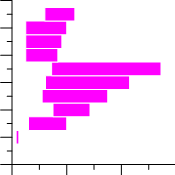Floating Bar Charts
|
Click the Home | New Graph | Bar | Horizontal Floating Bar Chart or Home | New Graph | Bar | Vertical Floating Bar Chart command to show the difference between two sets of Y values. For each X value, the length of each floating bar is drawn from the minimum Y value and rises to the maximum Y value. Floating bar charts can be oriented vertically or horizontally. The floating bar chart discussion assumes a vertical floating bar chart. Click the Vertical Floating Bar Chart or Horizontal Floating Bar Chart buttons to create floating bar charts. |
|
|
|
|
|
Vertical floating bar charts show the difference between two Y values per one X value. |
Horizontal floating bar charts show the difference between two X values per one Y value. |
Creating a New Floating Bar Chart
To create a floating bar chart:
- Click the Home | New Graph | Bar | Horizontal Floating Bar Chart or Home | New Graph | Bar | Vertical Floating Bar Chart command.
- Select a data file in the Open Worksheet dialog. You can select a new data file or you can select an open data file in the Open worksheets section.
- Click the Open button. A floating bar chart is created using the default properties.
Editing Floating Bar Chart Properties
To change the features of a floating bar chart, including the columns used to create the chart, first select the floating bar chart in the plot window or Object Manager and then edit its properties in the Property Manager.
Click the following tabs in the Property Manager to change different properties:


